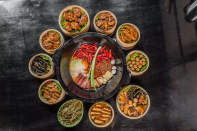Truth matters. Community matters. Your support makes both possible. LAist is one of the few places where news remains independent and free from political and corporate influence. Stand up for truth and for LAist. Make your year-end tax-deductible gift now.
The LAist guide to picking your turkey

Yes, it's the week before, but since so many of us are procrastinators, we assume there's plenty of you who still need to pick up a turkey. With so many options, however, it’s easy to get overwhelmed.
There's the standard supermarket turkey, (affordable, and specially bred for a large breast size so there's plentiful white meat). But there's also many other types — heirloom, heritage, regenerative, and organic to name a few — which offer other features.
I wanted to know their differences, so I asked Jon Regalado, head butcher at Gwen Butcher Shop & Restaurant in Hollywood, for an expert breakdown. They have a beautiful meat counter with various top-shelf cuts and charcuterie.
Know your bird
Let's start with heirloom, which refers to an old-world breed of turkey. “Essentially the same turkey that the pilgrims ate on the first Thanksgiving,” Regalado said.
Heirloom turkeys are larger than the average turkey, an important consideration when cooking for a crowd. Because they’re not bred to have a large breast size, they contain a more equal ratio of light and dark meat, with richer and more complex flavors. They also tend to be grown longer before being harvested, usually around eight months.

They tend to be more expensive than traditionally bred turkeys because, Regalado says, “It takes the farmer a little longer to raise, more feed, and more time between harvesting."
Meanwhile, heritage turkeys are similar to heirloom turkeys but tend to be smaller. Confusingly, the terms may be used interchangeably at stores.
A regenerative-raised turkey means the bird came from a farm that, among other sustainability measures, takes a holistic view, considering soil health and using fresh well water to clean its barn and pastures. This reduces groundwater use and has less of an impact on the environment.
The great outdoors
Outdoor access is also a distinguishing factor — how much opportunity the turkey has to move around, which helps it grow and develop muscle in its legs. Heirloom, heritage, and regenerative turkeys tend to be raised in a pasture setting, while a traditional turkey (also known as a broad-breasted turkey) is typically raised in covered areas.

Check out these local butcher shops for all your Thanksgiving needs.
- Location: 6600 Sunset Blvd, Los Angeles
- Hours: Tuesday through Sunday, 10 a.m. to 8 p.m.
- Location: East 3141 Glendale Blvd, Los Angeles; and West 1426 Montana Ave, Santa Monica
- Hours: Monday through Saturday, 10 a.m. to 7 p.m.; Sunday, 10 a.m. to 5:30 p.m.
- Location: 7016 Melrose Ave, Los Angeles
- Hours: Monday through Friday, 11 a.m. to 6 p.m.; Saturday through Sunday, 9 a.m. to 5 p.m.
Another consideration is diet. Many heritage, heirloom, and regenerative turkeys eat natural grass that hasn’t been treated with harmful chemicals and pesticides. They also have the opportunity to feast on various insects, which provide healthy nutrients for the animal's weight gain. Meanwhile, a turkey raised organically (which can be any breed) means it’s been fed a non-GMO vegetarian diet.
If you’re looking for an organic turkey, you’re probably looking for a USDA organic seal. But Regalado says if you buy directly from a small farm, it may not have one, even if it’s organic or was raised sustainably. That’s because getting the certification can be costly to smaller farms, so he recommends you check to learn more about their specific processes.
Going local
You may have thought about finding a turkey from a local farm. That may be tough in Southern California, where turkey farming isn’t common, but it’s not wholly foreign to other parts of California. Farms can be found in more remote agricultural areas in Central and Northern California, such as Diestel, where many local Whole Foods source turkeys. However, many others are sourced from back East; Regalado said he sources turkeys from Joyce Farms in North Carolina.

Regalado says the best turkeys can be found in a local butcher shop that supports small farms. He recommends calling ahead to see what they still have in stock, as some places might be ready to start selling out.











